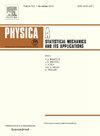Recovery of contour nodes in interdependent directed networks
IF 2.8
3区 物理与天体物理
Q2 PHYSICS, MULTIDISCIPLINARY
Physica A: Statistical Mechanics and its Applications
Pub Date : 2025-02-01
DOI:10.1016/j.physa.2024.130335
引用次数: 0
Abstract
Extensive research has focused on studying the robustness of interdependent non-directed networks and the design of mitigation strategies aimed at reducing disruptions caused by cascading failures. However, real systems such as power and communication networks are directed, which underscores the necessity of broadening the analysis by including directed networks. In this work, we develop an analytical framework to study a recovery strategy in two interdependent directed networks in which a fraction of nodes in each network have single dependencies with nodes in the other network. Following the random failure of nodes that leaves a fraction intact, we repair a fraction of nodes that are neighbors of the giant strongly connected component of each network with probability or recovery success rate . Our analysis reveals an abrupt transition between total system collapse and complete recovery as is increased. As a consequence, we identify three distinct phases in the parameter space: collapse despite intervention, recovery enabled by the strategy, and resilience without intervention. Moreover, we demonstrate our strategy on a system built from empirical data and find that it can save resources compared to a random recovery strategy. Our findings underscore the potential of targeted recovery strategies to enhance the robustness of real interdependent directed networks against cascading failures.
求助全文
约1分钟内获得全文
求助全文
来源期刊
CiteScore
7.20
自引率
9.10%
发文量
852
审稿时长
6.6 months
期刊介绍:
Physica A: Statistical Mechanics and its Applications
Recognized by the European Physical Society
Physica A publishes research in the field of statistical mechanics and its applications.
Statistical mechanics sets out to explain the behaviour of macroscopic systems by studying the statistical properties of their microscopic constituents.
Applications of the techniques of statistical mechanics are widespread, and include: applications to physical systems such as solids, liquids and gases; applications to chemical and biological systems (colloids, interfaces, complex fluids, polymers and biopolymers, cell physics); and other interdisciplinary applications to for instance biological, economical and sociological systems.

 求助内容:
求助内容: 应助结果提醒方式:
应助结果提醒方式:


